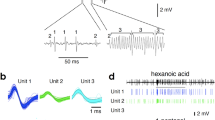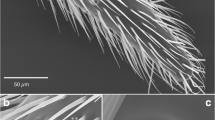Summary
-
1.
A two-chambered tentacular olfactometer was constructed (Fig. 1). This device permits the local delivery of odors to the tentacular sensory epithelium, with independent control over concentration on the left and right sides. The occurrence of discrete head turns during locomotion, subject to criteria of latency and extent, was indicative of olfactory orientation response.
-
2.
Concentration-response profiles were obtained by delivering odors unilaterally (Fig. 8). The snails turned towards the vapors of amyl acetate, hexanoic acid, butyric acid and 2-octanol. The threshold sensitivities (typically, at 10−7 molar concentrations) were at least two orders of magnitude higher than comparable thresholds reported for other animals (Table 3). In contrast to the odors listed above, there were no reliable orientation responses for acetaldehyde, valeraldehyde, trans-2-hexenal or ethanol.
-
3.
None of the odors reliably elicited turning away from the stimulus, despite the observation of tentacular retractions associated with some odors at high concentration, indicating aversive stimulation (Fig. 8, Table 2).
-
4.
When amyl acetate was delivered at different concentrations to the two tentacles, the difference between the number of turns towards the strong side and towards the weak side increased as a function of the Weber fraction, with 0.75 being the minimum Weber fraction at which the difference was statistically significant (Fig. 9).
-
5.
The methodology was relatively insensitive to inter-observer variations (Fig. 4). However, some factors which did affect the results in particular experiments were age of the snails (Fig. 5), hunger motivation (Figs. 6 and 7) and order of stimulus presentation (Fig. 6).
Similar content being viewed by others
References
Boeckh J (1967) Reaktionsschwelle, Arbeitsbereich und Spezifität eines Geruchsrezeptors auf der Heuschreckenantenne. Z Vergl Physiol 55:378–406
Chase R (1981) Electrical response of snail tentacle ganglion to stimulation of the epithelium with wind and odors. Comp Biochem Physiol [A] 70:149–155
Chase R, Croll RP (1981) Tentacular function in snail olfactory orientation. J Comp Physiol 143:357–362
Chase, R, Kamil R (in press) Morphology and odor sensitivity of regenerated snail tentacles. J Neurobiol
Chase R, Pryer K, Baker R, Madison D (1978) Responses to conspecific chemical stimuli in the terrestrial snailAchatina fulica (Pulmonata: Sigmurethra). Behav Biol 22:302–315
Croll RP, Chase R (1980) Plasticity of olfactory orientation to foods in the snailAchatina fulica. J Comp Physiol 136:267–277
Dethier VG (1952) Adaptation to chemical stimulation of the tarsal receptors of the blowfly. Biol Bull 103:178–189
Dethier VG, Hackley BE Jr, Wagner-Jouregg T (1952) Attraction of flies by iso-valeraldehyde. Science 115:141–142
Johnsen PB, Teeter JH (1980) Spatial gradient detection of chemical cues by catfish. J Comp Physiol 140:95–99
Johnson AE, Nunsten HE, Williams AA (1971) Vegetable volatiles: a survey of components identified. Chem Ind 1971:556–565, 1212–1224
Kaissling K-E (1971) Insect olfaction. In: Beidler IM (ed) Chemical senses, part 1: Olfaction. Springer, Berlin Heidelberg New York (Handbook of sensory physiology, vol IV, pp 351–431)
Kafka WA (1970) Molekulare Wechselwirkungen bei der Erregung einzelner Riechzellen. Z Vergl Physiol 70:105–143
Lange WH, MacLeod GF (1941) Metaldehyde and calcium arsenate in slug and snail baits. J Econ Entomol 34:321–322
Martin H (1964) Zur Nahorientierung der Biene im Duftfeld, zugleich ein Nachweis für die Osmotropotaxis bei Insekten. Z Vergl Physiol 48:481–533
Moulton DG (1980) Odorant emission preceding earthquakes and odor detection and recognition in animals. Proc Conference XI, Abnormal animal behavior prior to earthquakes, II, US Dept Interior, Geological Survey
Müller W (1968) Die Distanz- und Kontaktorientierung der Stechmücken (Aedes aegypti) (Wirtsfindung, Stechverhalten und Blutmahlzeit). Z Vergl Physiol 58:241–303
Neuhaus W (1953) Über die Riechschärfe des Hundes für Fettsäuren. Z Vergl Physiol 35:527–552
Pickett JA, Stephenson JW (1980) Plant volatiles and components influencing behavior of the field slug,Deroceras reticulatum (Müll.) J Chem Ecol 6:435–444
Sahley C, Gelperin A, Rudy JW (1981) One-trial associative learning modifies food odor preferences of a terrestrial mollusc. Proc Natl Acad Sci USA 78:640–642
Sass H (1978) Olfactory receptors on the antenna ofPeriplaneta: response constellations that encode food odors. J Comp Physiol 128:227–233
Schwarz R (1955) Über die Riechschärfe der Honigbiene. Z Vergl Physiol 37:180–210
Selim SI (1973) The control of snail and slug pests in agriculture. PhD thesis, Univ Calif Davis, Dept of Agricultural Chemistry
Skramlik E von (1948) Über die zur minimalen Erregung des menschlichen Geruchs- bzw. Geschmackssinnes notwendigen Molekülmengen. Plügers Arch 249:702–716
Author information
Authors and Affiliations
Rights and permissions
About this article
Cite this article
Chase, R. The olfactory sensitivity of snails,Achatina fulica . J. Comp. Physiol. 148, 225–235 (1982). https://doi.org/10.1007/BF00619129
Accepted:
Issue Date:
DOI: https://doi.org/10.1007/BF00619129




